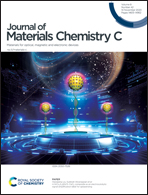Enhanced tribocatalytic degradation using piezoelectric CdS nanowires for efficient water remediation†
Abstract
Friction-driven contaminant degradation is a novel and potential solution to mitigate environmental pollution. However, the core mechanism of tribocatalytic degradation remains elusive. To understand the key parameters that affect tribocatalytic performance, we have synthesized CdS semiconductor nanowires with controllable piezoelectric properties. Intriguingly, only under magnetic stirring can these CdS nanowires degrade rhodamine B organic dye (as a representative organic pollutant) highly effectively in the dark, overcoming the drawback of the intermittent nature of sunlight in photocatalysis. In addition, the efficiency of tribocatalysis can be greatly improved through enhancing the friction or increasing the interfacial area between the stirring rods and the container. Further analysis indicates that piezoelectric CdS nanowires with higher aspect ratios enable more efficient charge carrier separation and transfer, playing a pivotal role in enhancing the degradation of organic compounds. Our findings blaze a new trail for removing harmful pollutants from wastewater and pave the way for many important applications through utilizing friction energy.



 Please wait while we load your content...
Please wait while we load your content...